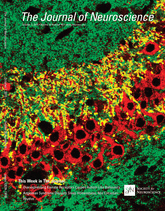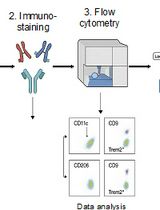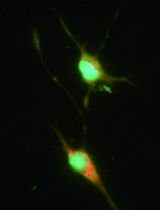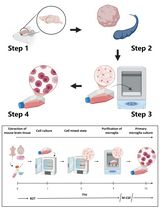- EN - English
- CN - 中文
Mouse Subependymal Zone Explants Cultured on Primary Astrocytes
小鼠室管膜下区外植体在原代星形胶质细胞中的培养
发布: 2016年07月20日第6卷第14期 DOI: 10.21769/BioProtoc.1876 浏览次数: 8872
评审: Oneil G. BhalalaJoseph C. ChenAnonymous reviewer(s)
Abstract
Neuroblast migration is a major component in the process of neuronal circuit assembly. In the rodent postnatal brain, the subependymal zone (SEZ) is the largest neurogenic niche where new neurons are born throughout life. These cells migrate several millimeters following a specific pathway called the rostral migratory stream (RMS) towards the olfactory bulb. Once they reach their final destination, they differentiate mainly as interneurons and integrate into already established neuronal circuits. Along the RMS, neuroblasts use a particular mode of migration known as chain migration. They stay attached to each other while migrating and are intimately associated with adjacent astrocytic processes. To dissect the molecular and cellular signals involved in neuroblast migration, we developed an in vitro system consisting of SEZ-derived explants co-cultured on top of an astrocyte monolayer.
Keywords: Neuroblast (成神经细胞)Materials and Reagents
- 10 cm Petri dishes (Greiner Bio-One GmbH, catalog number: 664160 )
- 15-ml tube
- 75 cm2 plastic flasks (Sigma-Aldrich, Corning® CellBIND®, catalog number: CLS3290 )
- Glass coverslips (Marienfeld-superior 18 mm Φ)
- 24-well plates (Sigma-Aldrich, Greiner Cellstar®, catalog number: M8812-100EA )
- Breakable razor blades (Fine Science Tools, catalog number: 10050-00 )
- Puradisc 30 syringe filters (Whatman, Whatman®, catalog number: 10462200 )
- Animals: Wild-type C57BL/6 mice (Charles River)
Note: Animal care and procedures were according to local and international regulations for the use of experimental animals. Animal handling was performed by trained staff certified by the Federation of European Laboratory Animal Science Associations (FELASA). - Antibodies:
- Goat anti-DCX (Santa Cruz Biotechnology, catalog number: sc-8066 )
- Mouse anti-GFAP (Sigma-Aldrich, catalog number: G-3893 )
- Anti-goat conjugated to Alexa Fluor 488 (Thermo Fisher Scientific, catalog number: A11055 )
- Anti-mouse conjugated to Alexa Fluor 647 (Thermo Fisher Scientific, catalog number: A31571 )
- Papain (Sigma-Aldrich, catalog number: P4762 )
- DNase I (Sigma-Aldrich, catalog number: D4513 )
- Dulbecco’s modified Eagle’s media (DMEM) (Thermo Fisher Scientific, catalog number: 41965039 )
- Fetal bovine serum (FBS), heat inactivated (Thermo Fisher Scientific, catalog number: 10270-106 )
- Trypsin–EDTA (0.05%) (Thermo Fisher Scientific, catalog number: 25300-054 )
- Poly-L-lysine (Sigma-Aldrich, catalog number: P9155 )
- Neurobasal media (Thermo Fisher Scientific, 21103049 )
- 4% paraformaldehyde (PFA) (Carl Roth, catalog number: P087.3 )
- Phosphate buffer saline (PBS)
- PBS-Triton
- Bovine Serum Albumin (BSA)
- Mowiol (Sigma-Aldrich, catalog number: 324590 )
- NaCl (Sigma-Aldrich, catalog number: 31434-1KG-R )
- KCl (AppliChem GmbH, catalog number: A1039 )
- Na2HPO4 (VWR International, Prolabo, catalog number: 28029.292 )
- KH2PO4 (GERBU Biotechnik, catalog number: 2018 )
- Glucose (Sigma-Aldrich, catalog number: G-7021 )
- HEPES (Carl Roth Gmbh, catalog number: 9105.2 )
- B27 supplement (Thermo Fisher Scientific, 17504044 )
- L-glutamine (Thermo Fisher Scientific, catalog number: 25030-024 )
- Pen/Strep (Thermo Fisher Scientific, catalog number: 15140-122 )
- PBS-Glucose-HEPES (see Recipes)
- Neurobasal complete media (see Recipes)
- Dulbecco’s modified Eagle’s medium (DMEM)-10% serum (see Recipes)
- Papain solution (see Recipes)
- DNase I solution (see Recipes)
Equipment
- Standard pattern scissors sharp/blunt 14,5cm (Fine Science Tools, catalog number: 14101-14 )
- Stereomicroscope (Carl Zeiss, model: STEMI SV 6 ) supplemented with a halogen light source (Schott KL, model: 1500 LCD )
- Horizontal laminar flow bench (Azbil Telstar, model: H-100 )
- Biological safety cabinet (The Baker Company, model: SterilGARD e3 )
- Dumont #5 Forceps (Fine Science Tools, catalog number: 11251-20 )
- Graefe forceps-straight/serrated (Fine Science Tools, catalog number: 11050-10 )
- Neubauer chamber
- Scalpel Handle #3-12 cm (Fine Science Tools, catalog number: 10003-12 )
- Scalpel Blades #15 (Fine Science Tools, catalog number: 10015-00 )
- 37 °C, 5% CO2 incubator (Labotect, model: C200 )
- Bright field microscope
- Confocal microscope (Carl Zeiss, model: LSM 700 )
Procedure
文章信息
版权信息
© 2016 The Authors; exclusive licensee Bio-protocol LLC.
如何引用
Readers should cite both the Bio-protocol article and the original research article where this protocol was used:
- Dumitru, I., Monyer, H. and Alfonso, J. (2016). Mouse Subependymal Zone Explants Cultured on Primary Astrocytes . Bio-protocol 6(14): e1876. DOI: 10.21769/BioProtoc.1876.
-
Alfonso, J., Penkert, H., Duman, C., Zuccotti, A. and Monyer, H. (2015). Downregulation of Sphingosine 1-Phosphate Receptor 1 Promotes the switch from tangential to radial migration in the OB. Journal of Neuroscience 35(40): 13659-13672.
分类
神经科学 > 细胞机理 > 细胞分离和培养
细胞生物学 > 细胞分离和培养 > 细胞分离
您对这篇实验方法有问题吗?
在此处发布您的问题,我们将邀请本文作者来回答。同时,我们会将您的问题发布到Bio-protocol Exchange,以便寻求社区成员的帮助。
提问指南
+ 问题描述
写下详细的问题描述,包括所有有助于他人回答您问题的信息(例如实验过程、条件和相关图像等)。
Share
Bluesky
X
Copy link














